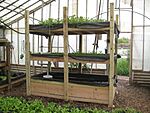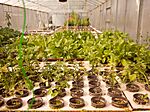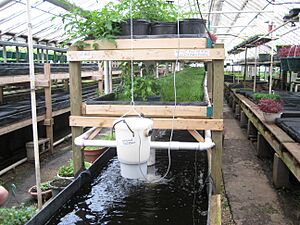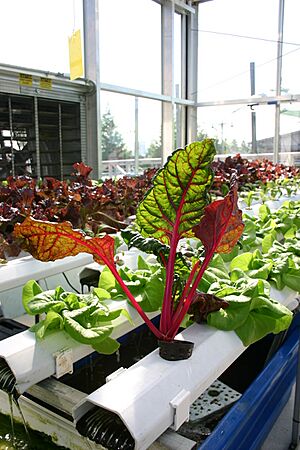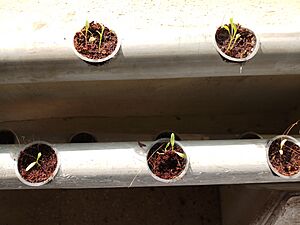Aquaponics facts for kids
Aquaponics is a cool way to grow food that combines two things: raising aquatic animals like fish in tanks (this is called aquaculture) and growing plants in water (this is called hydroponics). In aquaponics, the water from the fish tanks, which is full of nutrients from fish waste, is used to feed the plants.
The plants grow with their roots in this nutrient-rich water. They act like a natural filter, cleaning the water by taking out things like ammonia, which can be bad for the fish. Once the plants have cleaned the water, it's sent back to the fish tanks, fresh and full of oxygen.
Aquaponics systems can be big or small, simple or complex. You can grow many different kinds of food. Common fish include tilapia, koi, goldfish, and catfish. Popular plants are lettuce, kale, basil, tomatoes, peppers, and cucumbers. Fish, plants, and tiny helpers called microbes are the three main parts. Microbes turn fish waste into food for the plants.
Contents
Types of Aquaponics Systems
There are three main types of aquaponics systems. These are called media-based beds, floating rafts, and nutrient film technique. Each type works a bit differently to help plants grow.
Deep Water Culture Systems
In a deep water culture system, plants float on rafts in large water tanks. The plant roots hang down into the water. The plants are usually held in small net pots filled with materials like rockwool or coco fiber. This way, the roots are always in the water, getting all the nutrients they need.
Nutrient Film Technique Systems
The nutrient film technique uses long, narrow channels. Plants are placed in holes in these channels. A very thin layer of water flows past their roots. This thin film of water gives the plants nutrients and oxygen.
Media-Based Grow Beds
A media-based grow bed is a system where plants grow in a container filled with a special material. This material could be gravel or clay pebbles. It supports the plant roots and gives a home to helpful microbes. Water usually floods the bed and then drains away. This "ebb and flow" cycle delivers nutrients and oxygen to the plants. Using gravel or sand helps catch solid waste and provides a large surface for bacteria to clean the water. This often means you don't need a separate filter.
History of Aquaponics
Aquaponics has a long history, though people debate exactly when it started. It seems to have grown from old farming methods that mixed fish farming with growing plants.
Early Beginnings: Aztecs and Chinese
Some people think the Aztecs used an early form of aquaponics. They built floating islands called chinampas on lakes in Mexico. Plants grew on these islands. Waste from canals and cities was used to water the plants.
In South China and Southeast Asia, farmers grew rice in paddy fields with fish. This was a type of mixed farming. Fish like carp and pond snails lived in the paddies. This helped the rice grow.
A Chinese farming book from the 13th century described floating wooden rafts. These rafts were covered with mud and dirt. Farmers used them to grow rice and other plants in ponds. These floating planters were used in China as early as the 6th century.
Modern Aquaponics Developments
In the 1930s, farmers in Malaysia used systems where fish were grown in rice paddies. Similar systems have a long history in Indonesia.
Scientists began studying how to combine fish and plants in tanks in the 1960s and 1970s. They looked at how to clean water for fish using plants. In 1977, Ludwig C.A. Naegel wrote about growing tilapia fish and tomatoes together. This showed that a system recycling water could work for both.
Before the 1980s, combining hydroponics and aquaculture was hard. Many modern ideas for aquaponics came from the New Alchemy Institute and North Carolina State University.
New Alchemy Institute
In 1969, John and Nancy Todd started the New Alchemy Institute. They built a system like the Aztec's to grow vegetables and fish all year. Later, Ronald Zweig created a "hydroponic solar pond." This system used floating rafts for plants in a pond. These floating raft systems are now known as deep water culture.
North Carolina State University
Mark McMurtry and his team at North Carolina State University created the Integrated Aqua-Vegeculture System. This system used sand beds for growing plants with fish. It was one of the first closed-loop aquaponic systems. McMurtry's work showed that aquaponics really does work well.
University of the Virgin Islands
In 1979, James Rakocy and his team at the University of the Virgin Islands started testing media beds for aquaponics. They used gravel beds for plants and separate tanks for fish. By 1997, their research led to using deep water culture for large aquaponics systems.
Other Systems
Other researchers worked on "ebb and flow" systems. These systems use coarse materials like gravel. Water floods the beds and then drains out. These are sometimes called "Speraneo Systems" after Tom and Paula Speraneo, who created and sold guides for them.
In Canada, research in the 1990s led to automated, zero-waste aquaponics systems. These systems could work well even with low pH levels, which is good for plants. In China, large floating aquaponics systems were installed on fish ponds in 2009. They grow rice, wheat, and other crops.
What Does "Aquaponics" Mean?
The word "aquaponics" mixes "aquaculture" (farming water animals) and "hydroponics" (growing plants without soil). Before, people used longer names like "combined fish and vegetable production." The term "aquaponics" became popular after a magazine called the Aquaponics Journal started in 1997.
The "ponics" part comes from a Greek word meaning "work." So, aquaponics means "water work." This name describes how the system uses water to grow food.
Parts of an Aquaponic System
An aquaponics system has two main parts: the aquaculture part for raising water animals and the hydroponics part for growing plants. Depending on how fancy or expensive the system is, some parts might be combined.
Rearing Tank
This is the tank where you keep and feed your fish or other aquatic animals.
Hydroponic Subsystem
This is the part where the plants grow. They soak up extra nutrients from the water here.
Water Pump
A water pump is used to move the water around the system. It keeps the water flowing between the fish tanks and the plant beds.
Settling Basin (Optional)
This unit, also called a clarifier, catches uneaten food and tiny bits of waste. It helps settle out fine particles from the water.
Biofilter (Optional)
This is a special place where helpful bacteria can grow. These bacteria change harmful ammonia from fish waste into nitrates. Plants can use nitrates as food. A biofilter is not always needed, as some systems combine this function.
Sump (Optional)
Some systems use a sump. This is a tank at the lowest point. It has a pump that sends the cleaned water back to the fish tanks.
Live Components in Aquaponics
Aquaponics systems work because of a special partnership between three main living things: plants, fish (or other water animals), and bacteria. Sometimes, worms are also included.
Plants

- Plants are like the main producers in an aquaponics system. They use sunlight, carbon dioxide, and nutrients to grow.
- You can grow many different plants, including leafy greens, herbs, fruits, and vegetables.
- Plants help clean the water by taking out extra nutrients and waste.
- To keep the water balanced, farmers often grow plants at different stages. This means seedlings are growing at the same time as mature plants.
Fish (or Other Aquatic Creatures)
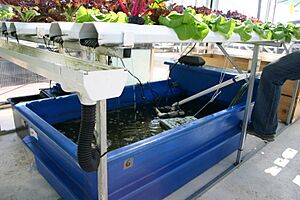
- Fish and other water animals are the main consumers. They provide protein for people and nutrients for the plants.
- Many types of fish can be used, like tilapia, goldfish, and koi.
- Fish help fertilize the plants by producing waste that is rich in nutrients.
Bacteria
- Bacteria are super important in aquaponics. They change ammonia from fish waste into nitrate. Nitrate is a nutrient that plants can use.
- Good bacteria, like Nitrosomonas and Nitrobacter, are needed to keep the system healthy and balanced.
- Bacteria help clean the water by removing extra ammonia and other waste products.
Algae
Algae are often seen as a problem in fish farming. But in some aquaponics systems, they can be helpful. In certain designs, algae are grown on purpose in the biofilter. They soak up extra nutrients, which helps keep the water clean. However, in other systems, algae in the fish tank are not wanted and need to be controlled. Some types of algae, like blue-green algae, can even produce toxins that harm fish.
Biofilter in Aquaponics
Fish waste and uneaten food build up in the water of fish farming systems. This water can become toxic to the fish if it's not cleaned. However, this "dirty" water is full of nutrients that plants need to grow.
In a stable aquaponics system, the levels of ammonia and nitrite are very low. Nitrate levels are higher, as this is the form of nitrogen that plants use. When a system first starts, it takes several weeks for the helpful bacteria to grow. During this time, ammonia and nitrite levels might be high. As the bacteria grow, they change ammonia into nitrite, and then nitrite into nitrate. This process is called nitrification. It also makes the water slightly acidic over time. Farmers might add things like potassium hydroxide to keep the water's pH balanced. They can also add other minerals like iron if needed.
How Aquaponics Systems Work
The main things you need for an aquaponics system are water, oxygen, light, food for the fish, and electricity to run pumps and filters. You also add young fish to replace the ones that grow big enough to be harvested. In return, an aquaponics system can constantly produce vegetables and edible fish.
Fish Food
Fish in aquaponics systems often eat food made from other fish. But catching too many wild fish for this food is not good for the environment. Some better options include growing duckweed in the system itself to feed the fish. You can also use worms from composting or even certain insect larvae, like black soldier fly larvae, to feed the fish.
Plant Nutrients
For plants to grow well, they need many different things in their roots. These include vitamins, hormones, and enzymes, which come from tiny microbes breaking down organic matter. Organic matter also helps plants get important micronutrients. Plants need both inorganic nutrients and these organic compounds to grow strong and healthy.
Water Use
Aquaponics systems are designed to save water. They recycle and reuse water instead of letting it drain away. The plants absorb nutrients from the water, which means less water needs to be replaced. Some studies show that aquaponics uses 90% less water than traditional farming methods.
You only add water to replace what the plants use, what evaporates, or what is lost when solid waste is removed. This means aquaponics uses only about 2% of the water needed for regular farming. This makes it great for places with little water or poor soil. Aquaponics can also help clean household wastewater, like a mini wetland.
Managing Fish Stock
To make money from aquaponics, you need to keep both the plants and fish producing as much as possible. Here are ways to manage the fish:
- Sequential rearing: You have fish of different ages in the same tank. When some fish are big enough, you take them out and add new baby fish.
- Stock splitting: You start with many small fish. When the tank gets too full, you split them into two groups.
- Multiple rearing units: You have several tanks that share a filter system. When fish in one tank are ready, you move fish from smaller tanks into bigger ones and start new baby fish in the smallest tank.
It's best not to have too many fish in one tank. This helps reduce stress for the fish and allows them to grow well.
Dealing with Pests and Diseases
Controlling pests and diseases in aquaponics can be tricky because you can't use many strong chemicals. Neem oil is a good natural pesticide, but only in small amounts so it doesn't harm the fish. It's best to watch for pests and diseases closely and try natural ways to control them. Plants grown in aquaponics might be stronger against diseases because of the helpful microbes in the water.
Automation and Monitoring
Modern technology has made aquaponics much easier. With smart sensors and IoT devices, systems can be mostly automatic. This means you can closely control things like nutrient levels, water use, and lighting. Automation makes aquaponics more efficient and can lead to better harvests. Some companies have even developed systems that use machine learning to find and remove sick plants.
Making Money with Aquaponics
Aquaponics offers a way for farmers to grow vegetables and raise fish at the same time. This means they have two ways to earn money, which can help if the market for one product goes down. Aquaponics systems can grow many different crops, from everyday vegetables to herbs and flowers.
People who care about the environment like aquaponics products because they are organic and don't use pesticides. The systems also use very little water and land. They can be set up in places with bad soil or dirty water. Plus, aquaponics systems usually don't have weeds, pests, or soil diseases, which helps grow good quality crops quickly.
While aquaponics is generally seen as good for the environment and potentially profitable, it can be hard to figure out the exact costs. Things like where the system is, the weather, and energy prices can change a lot. Some studies say aquaponics can become profitable after about two years.
One challenge for aquaponics businesses is that they need people who know a lot about both fish farming and plant growing. Also, many people don't fully understand what aquaponics is, so businesses might need to do more to explain it to customers.
Current Examples of Aquaponics
Europe
In March 2018, the European Aquaponics Association was created. This group helps European countries research and use aquaponics.
Asia
In Bangladesh, a team created low-cost aquaponics systems. These systems help people in areas with salty water or floods grow organic food and fish. In Gaza City, an aquaponics system was developed for use on rooftops.
North America
- Dakota College at Bottineau in Bottineau, North Dakota has an aquaponics program. Students can get a certificate or a degree in aquaponics there.
- The Denver Jail started an aquaponics program to feed inmates and officers.
- A group called "Amigos for Christ" in Nicaragua uses aquaponics to feed over 900 poor school children.
- The non-profit Growing Power in Milwaukee offers job training to young people while growing food for their community. This idea has spread to other cities like New Orleans and New York City.
- Whispering Roots in Omaha, Nebraska is a non-profit that uses aquaponics to provide healthy food to communities that need it.
- In cities like Chicago, people are using vertical aquaponics systems indoors. These systems can grow food all year with almost no waste.
Caribbean
The island of Barbados started a project to encourage home aquaponics systems. They hope to sell produce to tourists and rely less on imported food.
Many aquaponics gardeners around the world share their experiences online. They help each other build home systems and promote this type of gardening. There are also ready-made aquaponics systems for sale. These can grow herbs and vegetables indoors and look nice too. Universities are studying these smaller systems as they become more popular in cities.
See Also
- Rice-fish system
- Integrated multi-trophic aquaculture
- Vertical farming


